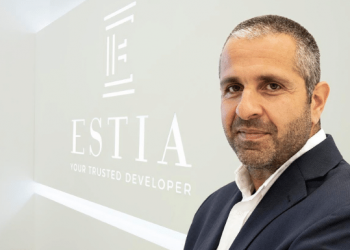Trei Real Estate is an international developer and owner of residential and retail units, with a varied portfolio that spreads across Europe (Germany, the Czech Republic, Slovakia, Portugal and Poland) as well as the United States.
CEEREM: Can you please paint us a brief picture of your career path at Trei and vision for the company?
After selling my international real estate venture that focused on offices and residential development all over the globe, I joined Trei in 2015 – just when they were planning on diversifying their commercial portfolio of supermarkets in Europe. By selling the investments we had in Hungary and Austria, as well as all the logistics portfolio, we were able to reinvest in multifamily units in Germany – although with a low-ish ROI, but with the benefits of a stable and predictable market. At the opposite pole, the United States was added as new investment market, offering us much higher yields but also provides a much more volatile market.
CEEREM: Given such a globally diversified portfolio, what is the niche that CEE occupies and relevance as part of your bigger plans?
While in 2015, we were just opening our tenth retail park in CEE, which for us includes the Czech Republic, Slovakia and Poland, and we are now inaugurating the 38th, while other 19 similar projects are in the works. We have a development pipeline for the next two and a half years because we open seven-eight retail parks per year. Three years ago, because the market was already saturated in Czech Republic and Slovakia, we decided to delve into the residential sector in Poland – with the goal to develop PRSs as soon as possible. Since the end of 2020, the demand for these properties increased dramatically, so we are now concentrating our attention on them, while also continuing our for-sale housing projects. Around 85% of our development pipeline consists of multifamily and roughly 15% of retail projects. In total circa 30% of our EUR 1.2 billion development pipeline is currently in CEE.
CEEREM: We know PRS is still fairly new to the Eastern market – what is your view on the challenges versus the growth potential of PRS in Poland?
In Poland, PRS represents under 1% of the total housing stock while the European average is 15%. With the younger population coming to live in the city, this sector will definitely become more popular, because it brings a great deal of flexibility to the owner. One of the main challenges is finding properly zoned land due to legal ambiguities that make long term rental zones extremely rare. Zoning is a dire problem in the Czech Republic too, with Prague lacking an updated local zoning plan since the mid ’90’s.
CEEREM: Even before the pandemic retail has been undergoing a transformation, and not everyone is coming out a winner – how are your retail assets faring?
All our retail parks are open air with direct access from the parking lot, so customers feel safer here than in a mall, for example. In Poland, units with sale areas under 2,000 square meters and grocery stores were allowed to remain open during lockdown, and as we fortunately fit both these requirements, we managed to remain profitable. Thanks to the lower rent and direct street access, mall retailers have also started migrating to retail parks.
CEEREM: Looking at the market dynamic in Poland – what is your strategy regarding keeping or exiting the residential projects you are currently developing?
Trei’s residential portfolio is mainly based in Germany for stability purposes, but the goal is to redirect the money into entrepreneurial investments in other countries. This means that a big portion of the residential projects we develop in Poland – where we are involved in joint venture partnerships in order to grow our portfolio faster – will be ultimately sold. The target is to deliver 1,000 apartments per year.
CEEREM: Other than divesting profits from various nooks of your portfolio, how easy are you finding access to capital at the moment on the Polish market?
Had you asked me this question five years ago, the answer would have been quite difficult for any investments excepting offices or shopping centers. However, this paradigm has totally shifted during the last two years, and we are currently getting at least one request every week from an institutional investor. ROIs for PRS in other European countries decreased so much (e.g. Scandinavia or Germany with -2,5%), that Poland is becoming really attractive with its net returns of up to 5%, even in Warsaw.
CEEREM: From your angle as a developer who conducts business both in the US and CEE – how do returns and challenges compare between two such disparate markets?
The United Sates market is somewhat more generous in returns than Poland, with an average of 4,5%-6%. We’re developing in the Southeast, in cities with huge demographic and economic potential and the expectations for rental apartments are completely different from Europe: swimming pools, fitness centers, dog parks and barbecue sites being absolute requirements in terms of usual amenities tenants expect to have. Costs are higher and rent less stable – totally opposite to Europe. However, the US has better land access. In terms of volatility, while the average stay of a tenant is around 10-12 years in Germany, in the US it’s around one-two years. We hope that Poland will settle somewhere in the middle.
CEEREM: What are your main priorities for Trei over the next two-three years?
The expansion of PRS in Poland is a key priority, as is increasing the number of residential projects developed for institutional investors on the German market. We see huge potential in Poland and the United States and will be keeping our eye on the ball for the time being.


















